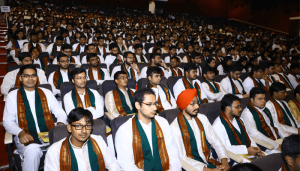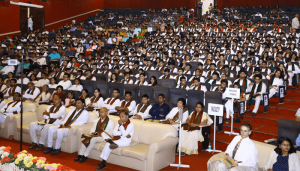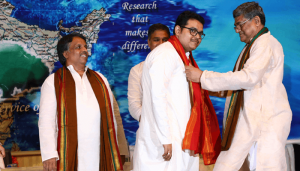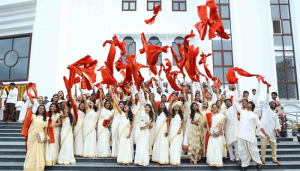What’s in an outfit after all? Well, apparently plenty, especially if it’s the official garb for convocation ceremonies. Even as there are mixed reactions to the traditional thrust by the Ministry of Human Resource Development (MHRD), we trace the roots of this controversy and find out what IIIT-H has been doing all along.
As if cocking a snoot at the colonial legacy left behind by the British, the iconic black gown, hood, mortar board and cap is giving way to sarees, dhotis, angavastras and the pagdis across Indian educational institutions. But the change hasn’t come overnight. The switch in the convocation attire had been coming with a few early adopters such as IIIT-H, but it got a boost last month when the Government decided to step in making traditional attire mandatory during convocation ceremonies for all public and private institutions under the University Grants Commission (UGC).
It was in Oct 2018 that the then Union Human Resource Development Minister Prakash Javadekar made headlines when he appealed to universities across the country to replace their “British-inspired” convocation attire with traditional Indian clothes, saying it would be a fitting tribute to Mahatma Gandhi on his 150th birth anniversary. But before that, in July 2018, the UGC had issued an advertisement inviting professional designers and students to send in their designs for a convocation outfit that would “depict Indian culture and tradition”. This shakeup in the Indian academic sartorial world can be traced back to 2010, when the then Environment Minister, Jairam Ramesh took off his black robe at a convocation ceremony of the Indian Institute of Forest Management at Bhopal, as a mark of protest terming it a “barbaric, colonial relic(s)”.

Origin of the black robe
According to a Washington Post article that quotes from the website of Columbia University, the black robe and cap as we know it today originated in the Middle Ages in Europe when a warm gown and hood were useful for scholars and the clergy in unheated buildings. By the second half of the 14th century, England prescribed the wearing of a long gown in many of its colleges, including Oxford and Cambridge as a standard academic outfit. And it was natural that these English academic sartorial traditions followed suit in all their colonies.
Tryst with Traditional
Like all other academic institutes, IIIT-H too originally conducted convocation ceremonies in the ubiquitous black gowns. But it was in 2009, that an official communique was circulated, laying out guidelines for a novel and compulsory dress code for all those receiving a degree. “We are going to have a dress code that suits our ethos”, it read. Mandating a kurta/pyjama or dhoti for men and a saree or salwar kameez for women, the circular specified the colour off-white or pale cream in handloom Mangalgiri cotton or silk.
“It was Jayanthi (Sivaswamy), Professor and Dean of Academics, who initiated the change in attire. The feeling was that it (black robe) was not suited for our kind of gathering and the question arose over its continuation. Instead it was proposed to switch to something more ethnic and one that matched our environment better. After it was decided to make the switch, I got involved,” says Professor Dipti Misra from the Language Technologies Research Centre, IIIT-H.
There were decisions to be made on the choice of material and the addition of a splash of colour to the otherwise staid outfits. Inspired by the traditional attire typically worn by men to complement the dhoti, the ‘angavastram’ or stole was included as part of the dress code. “We felt that we should gift something to the graduating students who are going out and we wanted it to be special. The hope was that the students would look upon the angavastram as a keepsake,” says Prof. Misra. Each program was assigned a colour with some reasoning behind the choice. “A lot of thought went into selecting the colours,” reminisces Prof. Misra. With the largest group of graduating students hailing from the BTech stream, the colour green was assigned to their angavastrams. “Green is the colour of fertility – so in that sense the (BTech) students who go out are going to spread what they learn here in the rest of the world,” she explains. A proposal to include faculty in the dress code too was mooted and accepted, with the only difference being in the angavastram colour assigned to them – mustard, to signify sophistication and respect.

By Hand From The Heart
In the first year of the new dress code, to facilitate the exercise of finding off-white traditional clothes, Mangalgiri cotton fabrics were procured in bulk from ApCo Fabrics (The Andhra Pradesh State Handloom Weavers Co-operative Society Ltd). And tailors were invited on campus to take measurements for customised stitching. The practice of procuring the off-white fabrics from ApCo continues to date, with a slight tweak. Now, bulk quantities of kurtas and pyjamas are stitched in various sizes and sold on campus. Recollecting the debut of the traditional attire, Suman Yelati, then a Masters student who was closely involved in this project says,“That first year, when we got custom-made outfits stitched for faculty (too), we handed them out in handmade paper bags crafted by the Housekeeping staff.” For the coloured stoles, the team, which now included Grace Nalini, currently with the Outreach department, headed to Suraiya Hasan Bose’s weaving studio. Suraiya has been an imminent figure in the handloom world, instrumental for the revival of the himroo and mashroo weaves. “The easiest thing to do would have been to go into the market and pick up something off the shelves. But we decided against that. We wanted it to be very special. Going to Suraiya was for us the most natural thing to do. Because we (the faculty) are the handloom types… For me personally, handloom is something which is more sustainable…a better material, with its own grace,” says Prof. Misra. It was here at Suraiya’s studio that bulk yardage of the finest cotton cloth featuring a border was selected, in various colours.

Initial Hiccups
The handloom weaving process is a complicated and time-consuming one. In the past, without sufficient advance notice, Suraiya’s studio has been unable to weave large quantities of cloth in the particular shades ready in time for convocation. Mentioning some of the early hiccups faced, Grace says, “One year, we had to go around to Koti and Charminar in search of similar material. We finally got it but only the border was green and the centre had a patch of white in it. So we had to fold it in such a way that only the green colour was visible (!)”. Now, an advance order is always placed with the studio to avoid such misadventures. Incidentally, with the exception of the PhD program, the angavastrams for all other programs are handed out by the office, to be collected by the students in advance so they can be worn for the occasion. “When we felicitate someone we drape a shawl, as a sign of giving away something. Similarly, for the PhD students, the angavastram is given to them on stage, usually by the chief guest or their supervisor,” says Prof. Misra.

Grammable Moment
The black cap with a tassle is symbolic of graduation. And for every graduate, throwing that cap in the air has become a defining moment to be captured for posterity. Little wonder then that when the ethnic attire was first proposed, it was met with resistance. “Yes, the students were not happy. There were voices of dissent,” confirms Suman. But Prof. Misra is quick to add that the objections were not overwhelming. In fact on the graduation day at the ceremony, there was a pleasant surprise in store when students turned up in their own ethnic variants of traditional attire. “There were dhotis, lungis, tamba or tehmat (a sarong-like bottom) and more!, exclaims Suman.
According to the staff, in the subsequent years, there has never been even a murmur of discontent from the students over the choice of attire. “There is some sort of festival mood…if convocation is around the corner!”, says Grace with a beaming smile. With other Hyderabad-based institutes following suit over the last few years, IIIT-H has often been consulted on the logistics of the attire change. As for capturing the iconic moment, the striking pictures of students throwing their coloured angavastrams in the air has become indicative of a IIIT-H convocation.



